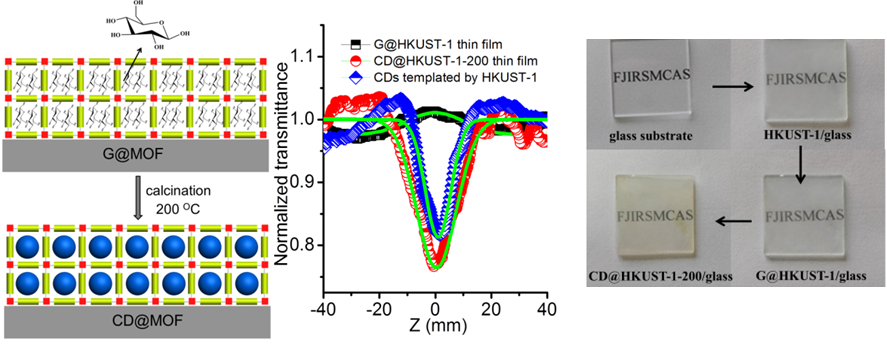The efficient and economical preparation of functional composite thin film materials is one of the challenges in the development of new thin film materials, particularly the development of composite thin films for optical applications. Metal-free carbon nanodots (CDs) exhibit a number of interesting photo-physical behaviors, particularly in regard to photoluminescent properties. Since CDs also offer favorable chemical properties, such as high chemical stability, low toxicity, and good biocompatibility, these nanoparticles have received huge research interest. A number of applications of CDs have been suggested or already realized in several areas.
Many different methods have been developed for synthesizing CDs, including microwave irradiation, arc discharge, laser ablation, electrochemical oxidation, and hydro/solvothermal carbonization. Despite these substantial efforts, the fabrication of CDs with uniform size distribution and morphology remains a challenging task.
Prof. ZHANG Jian's research team at the State Key Laboratory of Structural Chemistry, Fujian Institute of Research on the Structure of Matter, Chinese Academy of Sciences, has recently made research progress in the synthesis of ultra-small photoluminescent carbon CDs with a low-temperature calcination approach with rather inexpensive reactants. Crystalline metal-organic frameworks (MOFs) materials with ordered pores offer the potential of serving as templates for CD synthesis, which are composed of metal ion nodes and organic ligand linkers.
Under chosen reaction conditions, these ordered micropores can serve as confined nanoreactors. After glucose molecules had been loaded into the pores of MOFs, well-defined CD arrays were produced by heating to 200°C. The size and spacing of the CDs could be controlled by the choice of templating MOF: HKUST-1, ZIF-8, or MIL-101. The sizes of the obtained CDs were approximately 1.5, 2.0, and 3.2 nm, which are close to the corresponding MOF pores sizes.
The resulted CD arrays exhibited interesting photophysical properties, including photoluminescence with tunable emission and pronounced nonlinear optical (NLO) effects. The NLO properties of the obtained CD arrays were significantly different from those of a CD suspension, thus indicating the existence of collective phenomena. Finally, the recent progress in the fabrication of well-defined MOF and SURMOF coatings would fulfill the basic requirement for the straightforward fabrication of devices and sensors with various applications.
The results are published in Angew. Chem. Int. Ed. 2017, (DOI: 10.1002/anie.201702162)
At the same time,this research team have synthesized the oriented report an oriented and homogenous cobalt-metalloporphyrin network (PIZA-1) thin film prepared by liquid phase epitaxial (LPE) method for highly selective adsorption of volatile organic compounds (VOCs) (Small, 2017, 1, 1604035).
In addition, they systematically studied the growth orientations, thickness and substrate dependent on the properties of MOF thin films on chirality and catalysis (the related publications: Chem. Commun., 2017, 53, 1470;ACS Appl. Mater. Interfaces, 2017, 9, 7259;Inorg. Chem., 2017, 56, 3526;Nanoscale 2017, DOI:10.1039/C7NR02284K).

MOF-Templated Synthesis of Ultra-Small Photoluminescent Carbon Nanodot Arrays for Optical Applications
publications links:
http://onlinelibrary.wiley.com/doi/10.1002/anie.201702162/abstract
http://dx.doi.org/10.1002/smll.201604035
http://pubs.rsc.org/en/content/articlelanding/2017/nr/c7nr02284k#!divAbstract
http://pubs.acs.org/doi/abs/10.1021/acs.inorgchem.6b03140
http://pubs.acs.org/doi/abs/10.1021/acsami.6b14541
http://pubs.rsc.org/en/content/articlelanding/2017/cc/c6cc08342k#!divAbstract